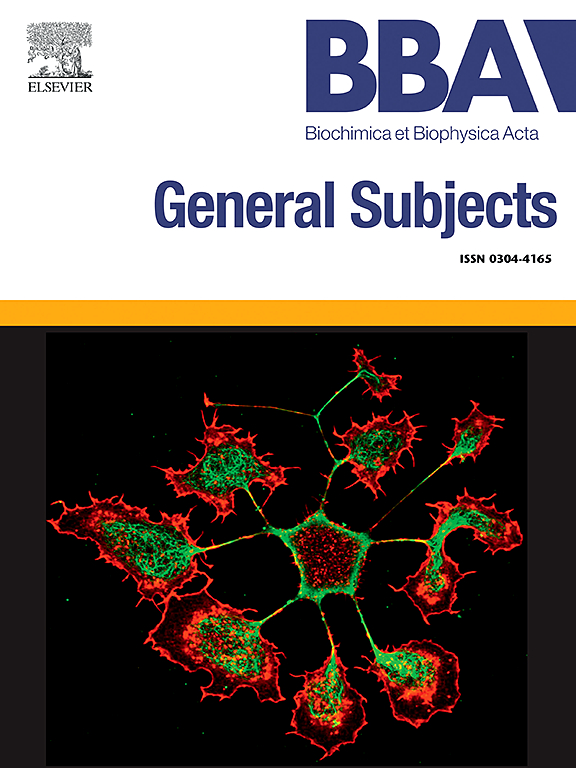载四环素磷酸钙纳米颗粒杀灭多重耐药细菌的分子机制。
IF 2.8
3区 生物学
Q3 BIOCHEMISTRY & MOLECULAR BIOLOGY
Biochimica et biophysica acta. General subjects
Pub Date : 2025-01-01
DOI:10.1016/j.bbagen.2024.130733
引用次数: 0
摘要
背景:在早期的通信中,我们报道了抗生素四环素(Tet)的纳米化,方法是将其包裹在生物相容性和高度穿透膜的纳米载体分子-磷酸钙纳米颗粒(CPNP)中。合成的Tet-CPNP在体外和体内(小鼠)杀死了不同的tet耐药细菌。此外,这种纳米四环素具有杀菌作用模式,而不是散装四环素的抑菌作用模式。本研究揭示了Tet-CPNP的分子作用机制。方法:采用分光光度法、荧光光谱法、圆二色法、凝胶电泳和透射电镜等技术,研究Tet- cpnp /Tet与完整70S细菌核糖体的相互作用模式。结果:实验观察发现(i) Tet-CPNP与核糖体的结合亲和力高于仅四环素;(ii) Tet-CPNP与核糖体的结合,而与四环素的结合,使核糖体构象松散,最终破坏和降解核糖体。结论:Tet-CPNP的杀菌作用源于细胞核糖体的降解,从而阻断蛋白质翻译现象。因此,Tet-CPNP可以解决四环素这种廉价的第一代广谱抗生素因产生大量四环素耐药菌而过时的问题。本文章由计算机程序翻译,如有差异,请以英文原文为准。

Molecular mechanism of action of tetracycline-loaded calcium phosphate nanoparticle to kill multi-drug resistant bacteria
Background
In earlier communications we reported about nanonization of the antibiotic tetracycline (Tet) by entrapping it within the biocompatible and highly membrane penetrating nano-carrier molecule – calcium phosphate nanoparticle (CPNP). The synthesized Tet-CPNP killed different Tet-resistant bacteria in vitro as well as in vivo (in mice). Moreover, such nanonized tetracycline had bactericidal mode of action, in contrast to bacteriostatic mode of action of bulk tetracycline. The present study unveils the molecular mechanism of action of Tet-CPNP.
Methods
This study was conducted to investigate the mode of interaction of Tet-CPNP/Tet with intact 70S bacterial ribosome by the techniques of spectrophotometry, spectrofluorimetry, circular dichroism, gel electrophoresis and transmission electron microscopy.
Results
Experimental observations revealed that (i) binding affinity of Tet-CPNP was higher than that of only tetracycline with ribosome and (ii) binding of Tet-CPNP, but not of tetracycline, loosened ribosome conformation, finally disrupting and degrading ribosome.
Conclusion
Bactericidal action of Tet-CPNP was rooted from degradation of cellular ribosomes and thereby blockage of protein translation phenomenon. Therefore, the problem of obsolescence of tetracycline, a cheap, first-generation, broad-spectrum antibiotic, due to generation of huge tetracycline-resistant bacteria, can be removed by the Tet-CPNP.
求助全文
通过发布文献求助,成功后即可免费获取论文全文。
去求助
来源期刊

Biochimica et biophysica acta. General subjects
生物-生化与分子生物学
CiteScore
6.40
自引率
0.00%
发文量
139
审稿时长
30 days
期刊介绍:
BBA General Subjects accepts for submission either original, hypothesis-driven studies or reviews covering subjects in biochemistry and biophysics that are considered to have general interest for a wide audience. Manuscripts with interdisciplinary approaches are especially encouraged.
 求助内容:
求助内容: 应助结果提醒方式:
应助结果提醒方式:


